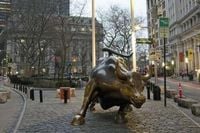Wall Street found itself on a rollercoaster ride Friday, September 5, 2025, as investors grappled with the latest signals from the U.S. job market and their implications for Federal Reserve policy. The day began with optimism—S&P 500 futures hit fresh record highs and the Nasdaq led early gains with a 0.4% rise, according to Invezz. Yet as the trading session unfolded, the mood shifted. The S&P 500 erased its early gains, closing 0.4% below the all-time high set just the day before, while the Dow Jones Industrial Average dropped 203 points, or 0.4%, after swinging wildly between a gain of 148 points and a loss of 409, as reported by the Associated Press.
The Nasdaq composite also slipped, down 0.1% by late morning. The volatility was driven by a pivotal U.S. Labor Department report showing that employers added fewer jobs in August than economists had expected. Making matters worse, the government revised its hiring estimates for June and July downward by a combined 21,000 jobs. This string of disappointing labor data, coming on the heels of already lackluster reports in previous weeks, sent a chill through markets and left investors questioning whether the economy is simply cooling off—or on the brink of something more serious.
"This week has been a story of a slowing labor market, and today’s data was the exclamation point," said Ellen Zentner, chief economic strategist for Morgan Stanley Wealth Management, as quoted by the Associated Press. The numbers were weak enough that Brian Jacobsen, chief economist at Annex Wealth Management, suggested the Fed might even consider a deeper-than-usual rate cut at its upcoming September 17 meeting.
Bond markets reacted decisively. Treasury yields tumbled, with the yield on the 10-year Treasury falling to 4.07% from 4.17% the previous day and from 4.28% at the start of the week. The two-year Treasury yield, which closely tracks expectations for Fed policy, dropped even more sharply to 3.47% from 3.59%. These moves signal investors’ growing conviction that the Fed will cut its main interest rate later this month—a probability traders pegged at 100% by midday, according to CME Group data cited by the Associated Press and Invezz.
For months, the Federal Reserve has been walking a tightrope. It has held off on rate cuts in 2025, wary of reigniting inflation, especially with ongoing concerns about tariffs. Yet the persistent weakness in job creation may have tipped the scales. Traders and analysts now overwhelmingly expect at least a quarter-point cut, with some arguing that the Fed could go even further to stimulate the economy.
Still, the data isn't so dire as to scream "recession," and the U.S. economy continues to grow—albeit more slowly. The central question on Wall Street is whether the labor market can remain in a "Goldilocks" zone: not too hot to stoke inflation, but not so cold as to trigger a downturn. This uncertainty is feeding the market’s recent swings, as investors try to gauge whether they’re headed for a soft landing or a more abrupt slowdown.
Amid all this, individual stocks told their own stories. Nvidia, the chipmaker at the heart of the artificial intelligence (AI) boom, became Friday’s heaviest drag on the market. After months of meteoric gains—and mounting criticism that its valuation had become unsustainable—Nvidia’s stock fell 2.9%. The sell-off reflected both profit-taking and a sense that the AI trade, while powerful, may have gotten ahead of itself in the short term.
In contrast, Broadcom delivered a jolt of optimism to the tech sector. The company’s stock jumped 9.3% after it reported quarterly profit and revenue that beat analysts’ expectations, according to Invezz. CEO Hock Tan credited "strong AI chip investment" and said the company expected revenue from this segment to accelerate. Broadcom also announced a $10 billion AI chip order, contributing to its record $110 billion order backlog—a detail that prompted Bank of America, JPMorgan, and Morgan Stanley to reaffirm buy ratings and raise price targets. As a result, Broadcom’s shares surged in pre-market trading, outshining rivals and underscoring the enduring appeal of AI-linked tech.
Other notable movers included Lululemon, which saw its stock plunge 18.1% after reporting quarterly revenue that missed expectations. CEO Calvin McDonald pointed to disappointing U.S. results, though he noted positive momentum internationally. CFO Meghan Frank cited "industrywide challenges, including higher tariff rates," as a headwind. Meanwhile, Tesla’s stock climbed 3% after the company proposed a potential $1 trillion payout package for CEO Elon Musk, contingent on the electric vehicle giant hitting ambitious targets over the next decade.
Smith & Wesson Brands also caught attention, jumping 6% after better-than-expected quarterly results, even as the company posted a loss. CEO Mark Smith highlighted strong demand for new products during what is typically a slow season for firearms sales.
Looking beyond U.S. borders, European equities provided a modest lift overnight, with Germany’s DAX and London’s FTSE both closing in the green. However, these gains faded as Wall Street turned lower. In Asia, markets fared better: Tokyo’s Nikkei 225 rallied 1% on strong earnings growth for Japanese workers, while Hong Kong and Shanghai indexes rebounded after recent declines, rising 1.4% and 1.2%, respectively.
Commodities reflected the day’s cross-currents. Gold slipped after a two-day climb, as some traders took profits, while crude oil futures gave back early gains amid fresh doubts about demand from China. These moves were a reminder that geopolitics and global economic data continue to loom large in investors’ minds, even as the U.S. jobs report remains the main swing factor for sentiment.
Technical indicators on Wall Street suggested the broader uptrend remains intact, with the S&P 500 and Nasdaq still trading near all-time highs and above key moving averages. Yet some analysts warned of potential short-term consolidation, especially given overbought conditions flagged by measures such as the Relative Strength Index (RSI).
As the dust settles, Wall Street’s focus now turns squarely to the Federal Reserve’s next move. Will the central bank deliver the rate cut that markets have all but priced in? Or will it surprise with a more aggressive stance to counteract the labor market’s recent weakness? For now, investors are left to ponder whether the economy can thread the needle—slowing just enough to warrant easier policy, but not so much as to tip into recession. That delicate balance will shape the path forward for stocks, bonds, and the broader economy in the weeks to come.



